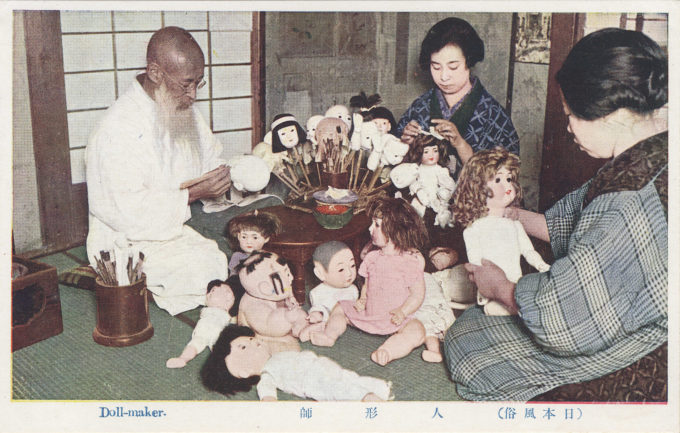
“Doll-maker”, c. 1930. While factories could mass-produce basic doll parts, the assembly and finishing of individual dolls was often a “cottage industry” in Japan, completed at small, home-based workshops.
See also:
Broken Dolls Festival, Tokyo.
Kewpie Dolls, Mochi & Mikan New Years’ card, c. 1920.
Doll Festival, c. 1940.
Boy on Rocking Horse, c. 1910.
“In the early 1910s some dolls and toys tailored to an American market began to be exported from Japan. [But] early attempts at Western style dolls were plagued with design and durability problems. It was not really until WWI cut off the traditional European doll supply that Japan began exporting large numbers of dolls and toys to the United States.
“… Among the earliest of the Japanese companies to make bisque dolls for America was the firm of Morimura Brothers. This company had its origins in the mid-18th century when the family came to Edo (Tokyo) and started a business manufacturing saddles and harnesses. By 1887 they were manufacturing porcelain goods.
“The family that owned the business saw the potential in the new world market for their company’s products and sent a son to university to learn English as they saw this as a business advantage for dealing with the West. They sent to America for assistance in designing and making the types of products American consumers would be pleased with. In June of 1915 they announced that their doll and toys department had been greatly enlarged.
“In 1916 Morimura opened a new factory solely for making dolls and toys. They produced all-bisque dolls, bisque socket and shoulder head dolls and celluloid dolls. Their line of ‘Full Jointed Dolls’ were open mouth dolly faced dolls made in a wide range of sizes.
“When the war came to an end, European doll manufacturers began to produce again and try to regain a foothold in the industry but bad feelings lingered for some time after the war. Japanese manufacturers were able to hold onto a piece of the American market through the end of the teens and into 1920 when world opinion again began to shift.
“The state of the Japanese worker and the low wage paid them combined with the return of traditional German and French dolls and the strength of the American doll manufacturing companies developed during the war years all came together to put an end to the dominance of the Japanese made dolls in America.
“Japanese dolls and toys would continue to hold a marginal place in the American market up until the advent of WWII.”
– The Dolls of Japan, by Ruby Lane, 2020

